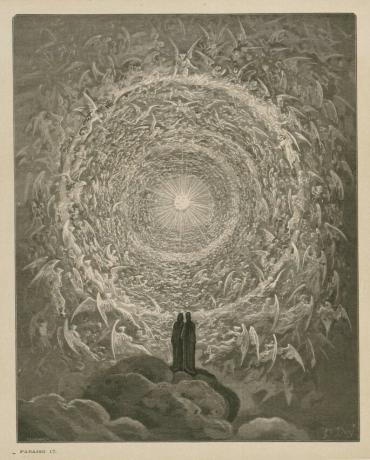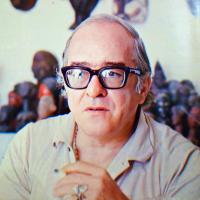Dante Alighieri's Divine Comedy: summary
The Divine Comedy, written by the Florentine Dante Alighieri between approximately 1304 and 1321, is an epic poetry, a literary genre that consists of the narration in verse of the exploits of heroes. Such feats are a model of virtue, whether true or fictitious. The Divine Comedy represents a compendium of medieval culture and knowledge, both religiously and philosophically, scientifically and morally.
Originally, the poem was called Comedy, a name that designated works with happy endings, as opposed to the classic concept of tragedy. When Giovanni Boccaccio was commissioned to write about the work, he called it Divine Comedy to demonstrate the centrality of Christian values.

We can summarize the structure and characteristics of the Divine Comedy as follows:
- An introductory song.
- Three chapters called Hell, Purgatory and Paradise.
- Each chapter is divided into thirty-three songs.
- The work adds a hundred songs in total.
- Hell is made up of nine circles.
- Purgatory is made up of nine rooms divided into: the anteroom, the seven steps, and the earthly paradise.
- Paradise is structured in nine spheres and the empyrean.
- All the songs are written in terza rhyme —Verse created by Dante—, whose stanzas are composed of hendecasyllable triplets of intertwined rhyme.
Why does Dante organize the play in this way? Due to the symbolic value of the numbers in the medieval imaginary. The numbers play an important role in the organization of the text and in the presentation of the ideas of the Divine Comedy. Namely:
- the number three, symbol of divine perfection and of the Holy Trinity;
- the number four, referring to the four elements, earth, air, water and fire;
- the number seven, symbol of the complete, complete. Also referred to the capital sins;
- the number nine, symbol of wisdom and the search for the highest good;
- the number one hundred, symbol of perfection.
Let us now know, in more detail, the plot of the work and the summary for each chapter: Hell, Purgatory and Paradise.
Resume

Dante, alter ego of the poet, he finds himself lost in the middle of a dark jungle. At dawn, he reaches an illuminated mountain, where he is besieged by three symbolic animals: a leopard, a lion, and a she-wolf. The soul of Virgilio, the Latin poet, comes to his aid and lets him know that his beloved Beatriz has entrusted him to take him to the gates of paradise. For that, they must first go through hell and purgatory.
In the first part of the journey, Virgil accompanies the pilgrim through nine infernal circles, in which Dante glimpses the lessons that impious sinners suffer.
In the second part, the pilgrim poet knows Purgatory, a place where sinful but contrite souls purify their sins to ascend to heaven.
In the third part, Dante is received by Beatrice at the gates of paradise, since Virgilio is prohibited from entering because he was a pagan. Dante knows the firmament and witnesses the victory of the saints and the glory of the Most High.
Enlightened and converted by revelation, the pilgrim poet returns to Earth and decides to bear witness to his journey in a poem for the warning and advice of humanity.
The main characters of the Divine Comedy they are essentially:
- Dante, the pilgrim poet, who represents the human condition.
- Virgil, poet of classical antiquity who represents rational thought and virtue.
- Beatriz, Dante's adolescent love, who represents faith.
Along with these, Dante makes mention, throughout the poem, of various characters from ancient, biblical and mythological history. It also refers to well-known figures from Florentine life in the fourteenth century.
Hell

O you who enter, abandon all hope!
The first part of the Divine Comedy it's hell. Dante and Virgilio first pass where the cowards are, whom the writer calls useless. Upon reaching the river Acheron, the poets meet the infernal ferryman, Charon, who carries souls to the gate of hell. On the door the following inscription reads: O you who enter, abandon all hope! Hell is structured by nine circles, where the damned are distributed according to their guilt.
First circle (not baptized)
The first circle is limbo or ante-inferno. In it are the souls that, although virtuous, did not know Christ or were not baptized, including Virgil himself. Her penalty is not being able to enjoy the gifts of eternal life. Only the patriarchs of Israel have been liberated from him.
Second circle of hell (lust)
Reserved for the sin of lust, one of the capital sins. It is Minos who, from the entrance, examines the souls and determines the punishment. There is Francesca Rimini, a noble woman from Italy who became a symbol of adultery and lust after her tragic end.
Third circle (gluttony)
Reserved for the sin of gluttony. Souls suffer in an infected swamp and freezing rain. In this circle is the can Cerbero and Ciacco.
Fourth circle of hell (greed and prodigality)
Reserved for the sin of greed. Wasters also have a place in it. The place is presided over by Pluto, whom the poet represents as a demon of wealth.
Fifth circle (anger and laziness)
Reserved for the sins of laziness and anger. Phlegias, son of the god Ares and king of the tombstones, is the ferryman who carries souls across the Styx to the infernal city of Dite. The poets meet Felipe Argenti, Dante's enemy. When seeing them, the demons enrage.
Sixth circle (heresy)
The Tower Furies of Dite and Medusa manifest. An angel helps them by opening the gates of the city to advance to the circle of unbelievers and heresiarchs, condemned to burning graves. There are the Epicurean nobles Farinata degli Uberti, a Ghibelline and Dante's adversary, and Cavalcante Cavalcanti, of the Guelph house. Virgilio explains to the poet the sins according to scholasticism.
Seventh circle of hell (violence)
Reserved for the violent, among whom are the tyrants. The guardian is the Minotaur of Crete. The poets are led by the centaur Nessus through a river of blood. The circle is divided into three rings o scraps, according to the gravity of the sin: violent against the neighbor; violent against themselves (suicidal included); and violent against God, natural law and art.
Eighth circle (fraud)
Reserved for the fraudulent and seductive. It is divided into ten circular and concentric moats. Here ruffians, flatterers, courtesans, practitioners of simony, fortune-tellers and impostors, barateros are punished (corrupt), hypocrites, thieves, counselors of fraud, schismatics and promoters of discord and, finally, counterfeiters and alchemists.
Ninth circle (betrayal)
Reserved for traitors. The poets meet the Titans and the giant Anteus carries them in his arms to the last abyss. It is divided into four graves distributed as follows: traitors to relatives, to the homeland, to its guests and to its benefactors. In the center is Lucifer himself. From there, they go out to the other hemisphere.
Purgatory

Here dead poetry resurfaces,
Oh, holy Muses who give me confidence!
Calliope raises her harmony somewhat,
and may the strength accompany my song
with which the breath of nine Magpies,
drowned, remission, hopeless!
Purgatory is the place in the afterworld where souls purify their sins in order to aspire to heaven. This idea, deeply anchored in the medieval imagination, is what Dante takes.
By invocation of the Muses, the poet reaches the shores of the island of Purgatory, located in the southern hemisphere. There they meet Cato of Utica, whom Dante represents as the guardian of the waters. Cato prepares them for the transit through purgatory.
Prepurgatory
The poets arrive at the antepurgatory in the boat propelled by an angel. They meet the musician Casella and other souls. Casella sings a song by the poet. When Cato arrives, he reprimands them and the group disperses. The poets note the presence of late converts and excolmuldos for their stubbornness (negligent procrastinators of conversion, the suddenly dead and the violently dead).
Later, the Italian troubadour, Sordello da Goito, guides them to the presence of the monarchs who must purge their lust for power. Among them are the royal houses of Bohemia, France, Aragon, Provence, Sicily and La Pulla.
At night, while she sleeps, Lucia transports him to the door of purgatory. Upon awakening, the custodian engraves seven "P's" on his forehead in reference to the capital sins, marks that will disappear as she ascends to heaven. The angel opens the doors with the mystical keys of repentance and conversion.
First tier (superb)
The first ring or first circle of purgatory is reserved for the sin of pride. There they contemplate sculptural examples of humility, such as the passage of the Annunciation. Later they also contemplate images of pride itself, such as the passages of the Tower of Babel. Dante loses the first letter "P".
Second tier (envy)
It is reserved for those who purge envy. Again, you contemplate exemplary scenes of virtue embodied in the Virgin Mary, Jesus himself preaching love of neighbor or passages from antiquity.
Third tier (anger)
The third circle is destined for the sin of anger. Virgilio explains to Dante the moral system of purgatory and reflects on misguided love. The central point is to affirm love as the principle of all good.
Fourth tier (laziness)
It is reserved for the sin of laziness. An important discussion takes place about free will and its relationship to human actions that arise from love, both for good and for evil. The effects of laziness are also remembered.
Fifth tier (greed)
In the fifth circle, greed is purged. On a landing in purgatory, poets contemplate examples of the virtue of generosity. Purgatory trembles because of the liberation of the soul of Estacio, a Latin teacher and poet who honors Virgilio.
Sixth tier (gluttony)
In this ring he purges the sin of gluttony. Estacio tells that, thanks to the prophecies of the Eclogue IV From Virgil, he freed himself from greed and embraced Christianity in secret. However, it was this silence that earned him the condemnation. The penitents are subjected to hunger and thirst. Dante is surprised to see Foresto Donati, saved by the prayers of his wife.
Seventh tier (lust)
Reserved for the lustful. Virgilio explains the generation of the body and the infusion of the soul. From a burning circle, the lustful sing the praises of chastity. They meet the poets Guido Guinizelli and Arnaut Daniel. The latter asks for prayer. An angel announces that Dante must go through the flames to reach the earthly paradise. Virgilio entrusts it to his free will.
The earthly paradise
In the earthly paradise, Matilde, a medieval virgin, who offers to guide him and reveal the wonders of paradise. They begin a journey through the Lethe River and a procession appears preceded by the seven gifts of the Holy Spirit. The procession represents the triumph of the Church. Beatriz appears and urges him to repentance. The poet is immersed in the waters of the Eunoes and regenerates.
The Paradise

The paradise of the Divine Comedy It is structured in nine spheres, and the souls are distributed according to the grace achieved. Virgilio and Dante separate. The poet begins with Beatriz the journey to the empyrean, where God dwells.
First sphere, the Moon (spirits who broke the vow of chastity)
The first sphere is the Moon, whose spots represent those who failed the vows of chastity. Beatriz explains the value of vows before God and what the soul can do to compensate for its lack. He begins the path to the second heaven where, upon arrival, he is reached by various active and beneficial spirits.
Second sphere, Mercury (active and beneficial spirits)
The spirit of Emperor Justinian informs Dante that on Mercury are those who left great works of action or thought for posterity. The poet asks why Christ decided the destiny of the cross as salvation. Beatriz exposes him the doctrine of the immortality of the soul and the resurrection.
Third sphere, Venus (loving spirits)
The third sphere is Venus, the destiny of lovers who managed to dominate his passion. The poet meets Carlos Martel, heir to the Hungarian throne, who exposes two contrary cases in his own family. Then Fulco de Marseille pointing out the sins of Florence, especially the greed of the clergy.
Fourth sphere, the Sun (doctors of philosophy and theology)
The fourth sphere is the Sun, where the doctors of theology and philosophy are found. Faced with the doubts that Dante expresses, the sages respond and teach. Saint Thomas Aquinas clarifies the superiority of Adam and Jesus Christ over the wisdom of Solomon. He also tells her about Saint Francis of Assisi. San Buenaventura praises Santo Domingo.
Fifth sphere, Mars (martyrs)
The fifth sphere is Mars. It is dedicated to the martyrs of Christendom, taken as warriors of faith. The souls of the martyrs are lights that gather to form a cross. Beatriz praises the fallen in the crusades, and Dante meets his ancestor Cacciaguida, who was crossed. This predicts the exile of Dante.
Sixth sphere, Jupiter (righteous rulers)
It is the sphere dedicated to good rulers, of which Jupiter as the god of the Greek gods, is the allegory. There Dante meets the great hierarchs of history considered righteous, such as Trajan, of whom a legend says he has converted to Christianity.
Seventh sphere, Saturn (contemplative spirits)
Saturn, the seventh sphere, is where those who lived contemplative life on earth rest. There Dante and San Damiano converse about the doctrine of predestination, monasticism and bad religious. Saint Benedict also expresses his disappointment in the face of the fate of his order. Dante and Beatriz begin the passage to the eighth sphere.
Eighth sphere, stars (triumphant spirits)
The eighth sphere corresponds to the stars of the constellation Gemini, which symbolize the militant Church. There, Jesus Christ and the Virgin Mary appear, whose coronation he attends. Beatriz asks Dante for the gift of understanding. Saint Peter questions him about faith; Santiago, on hope, and Saint John the Evangelist on love. Dante is victorious.
Ninth sphere, crystalline (angelic hierarchies)
The poet glimpses the light of God, surrounded by nine rings of heavenly cuts. Beatriz explains to Dante the correspondence between creation and the celestial world, and angels are described following the teachings of Saint Dionysus.
The Empyrean (God, angels and blessed)
Dante finally ascends to the empyrean, a place beyond the known physical world, the true abode of God. The poet is enveloped in light and Beatriz is clothed in unusual beauty. Dante distinguishes a great mystical rose, symbol of divine love, in which holy souls find their throne. Beatriz gets her place with Raquel. Dante will be driven on his final leg through San Bernanrdo. The Holy Trinity manifests itself to Dante in the form of three identical circles. After being enlightened, Dante opens his understanding of him and understands the mystery of divine love.
Dante Alighieri biography

Dante Alighieri (1265-1321) was a poet of Florentine origin, representative of the so-called Dolce stil nuovo (Sweet new style). His full name was Durante di Alighiero degli Alighieri. He was married to Gemma Donati since 1285. His first literary work was New life (1293), which was inspired by his love feelings by Beatriz Portinari, who died in 1290.
Dante ventured into political life in Florence from 1295. He participated with the Guelphs in the confrontation against the Ghibellines. He was ambassador in San Gimignano, high magistrate of Florence and member of the Special Council of the People and of the Council of Hundred. He suffered exile after being accused of opposition to the pope, corruption and administrative impropriety. He died in the city of Ravenna at 56 years of age.
Among his works are: Vita nuova; By vulgari eloquentia (reflections on popular speech); Divine Comedy Y Il convivio.



